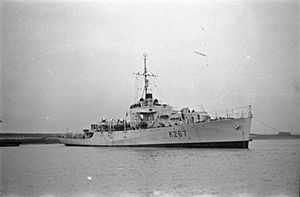SS Empire Javelin
| Career (UK) | |
|---|---|
| Class and type: | C1-S-AY1, Landing Ship Infantry |
| Name: |
Cape Lobos (laid down) Empire Javelin (completed) |
| Owner: | MoWT |
| Operator: | Blue Star Line |
| Port of registry: |
|
| Builder: | Consolidated Steel Corporation, Wilmington, CA |
| Launched: | 25 October 1943 |
| Completed: | January 1944 |
| Identification: |
UK official number 169774 call sign MYMQ |
| Fate: | Sunk on 28 December 1944 |
| General characteristics | |
| Tonnage: | 7,177 GRT tonnage under deck 6,087 4,823 NRT 11,650 tons displacement |
| Length: | 396.5 ft (120.9 m) |
| Beam: | 60.1 ft (18.3 m) |
| Depth: | 35.0 ft (10.7 m) |
| Propulsion: | 2 × steam turbines, single screw |
| Sensors and processing systems: | wireless direction finding gyrocompass |
| Armament: | 1 × 4 inch gun 1 × 12 pdr gun 12 × Oerlikon 20 mm cannon |
SS Empire Javelin was an Infantry Landing Ship or "LSI (Large)" in service with the UK in the latter part of the Second World War. She served as a troop ship in Operation Overlord, including "D-Day" on 6 June 1944.[1]
She was lost while en convoy to France with 1,483 troops aboard somewhere around the midpoint between Southampton, England, and Le Havre, France on December 28, 1944.[2] It is believed she struck a mine.[3]
History
Construction and operation
She was built by Consolidated Steel Corporation, Wilmington, California as the Cape Lobos, and transferred under the terms of lend lease on completion in January 1944 under the name Empire Javelin.[4][5] She was bareboat chartered by the War Shipping Administration to the Ministry of War Transport and managed by Blue Star Line.[5][6]
D-Day
The ship sailed from Portland Harbour anchorage on 5 June 1944, destined for Dog Green Omaha Beach, Normandy, after embarking troops of the 1st Battalion 116th Infantry regiment of US 29th Division by landing craft from Weymouth, Dorset.[7] Most notably, the ship carried members of Company A, 116th Infantry, who were from Bedford, Virginia. Bedford is the home of the United States' National D-Day Memorial. 551st Landing Craft Assault (LCA) Flotilla crewed by Royal Navy Volunteer Reserve (RNVR) of Combined Operations was based aboard Empire Javelin on D-Day. Six of the eighteen LCAs of 551st LCA Flotilla were lost on D-Day, with the remainder being severely damaged.
Loss

Having embarked US servicemen at Southampton for France, Empire Javelin was in the English Channel en route to Le Havre at 50°5′N 1°0′W / 50.083°N 1.000°WCoordinates: 50°5′N 1°0′W / 50.083°N 1.000°W on the afternoon of 28 December 1944 with 1,483 men aboard. Without warning there was an explosion; at least 20 lives were lost and 20 more injured.[8] Her escort, the Free French frigate L'Escarmouche, was called alongside once the extent of the damage had been assessed, and for approximately an hour the men on board jumped from the ship. Two minutes after the last man jumped off, there was a large explosion and the ship began settling by the stern. About 10 minutes later the ship was completely submerged.[8] Some pictures of the sinking can be seen here:
Initially it was thought that the ship had been torpedoed by German submarine U-772,[9] but it was later revealed that U-772 was sunk earlier that month.[10] Another U-boat, U-322, was active in the area on the same day, and was sunk on the next day south of Weymouth.[11] There is no definitive proof of what sank the Empire Javelin; it has been proposed that it was more likely to be a mine.[3]
Notes
- ↑ "Omaha Beach: American Troops". D-Day: The assault. D-Day: Etat Des Lieux.
- ↑ Schoichet's account of the sinking of Empire Javelin: "Noon of December 28 found us approaching the half way mark in the channel...Suddenly, without warning, the whole world erupted."
- ↑ 3.0 3.1 Helgason, Guðmundur (1995–2014). "Empire Javelin". Ships not hit by U-boats. Guðmundur Helgason.
- ↑ Colledge. Ships of the Royal Navy. p. 113.
- ↑ 5.0 5.1 Lloyd's Register, Steamers & Motorships (PDF). 1945. Retrieved 17 March 2014.
- ↑ "Empire – H –I – J". The 'Empire' Ships. Mariners.
- ↑ Winser, John de S (1994). The D-day Ships. Kendal: World Ship Society. p. 37. ISBN 0-905617-75-4.
- ↑ 8.0 8.1 The Daily Mirror, 11 July 1945
- ↑ Mitchell, WH; Sawyer, LA (1990). The Empire Ships (2nd ed.). London: Lloyd's of London Press. p. 427. ISBN 1-85044-275-4.
- ↑ Helgason, Guðmundur (1995–2014). "U-772". List of all U-boats. Guðmundur Helgason.
- ↑ Pocock, Michael W. "Daily Event for December 28, 2007". Maritime Quest.
References
- Colledge, J. J.; Warlow, Ben (2006) [1969]. Ships of the Royal Navy: The Complete Record of all Fighting Ships of the Royal Navy (Rev. ed.). London: Chatham Publishing. ISBN 978-1-86176-281-8. OCLC 67375475.
Further reading
- Balkoski, Joseph. Omaha Beach, D-Day, June 6, 1944. Mechanicsburg, PA: Stackpole Books. ISBN 978-0-8117-3376-2.
| ||||||
| ||||||||||||||||||||||||||
| ||||||||||||||||||